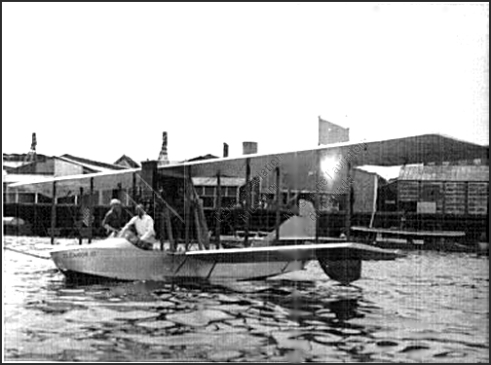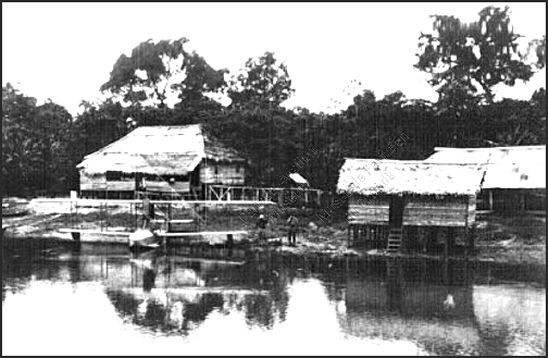
Scientific Expedition Exploring the headwaters of the Parima River in northwestern Brazil |
 |
Curtiss Seagull Flown by Lt. Walter Hinton from the Canada Aviation Museum |
|
TUESDAY, AUGUST 12, 1924 EXPLORER TO SEEK ORINOCO'S SOURCE Dr. Alexander Hamilton Rice Is Now at Para With His Wife and Flier Hinton VOYAGE TO TAKE 2 YEARS Seaplane and Radio Will Be Used to Penetrate Hitherto Uncharted Region With Dr. Rice is his wife, the former Mrs. George D. Widener, whose husband and son were lost with the Titanic, and Walter Hinton, who piloted the airship NC-4 across the Atlantic. Dr. Rice has with him a large hydroplane, apparatus for a powerful broadcasting station, shallow draught boats and a complete outfit for aerial photography. While the principal object is to seek the source of the Orinoco, he will explore the regions in which the Orinoco and the Amazon are connected by the great natural canal of Cassiquirae. The trip will take about two years, and he will go into sections of South America never yet reached by the white man. In his letter Dr. Rice says that trouble began before leaving Rio Harbor for Para and has kept up ever since. "The worst was the breaking of the steering gear," the letter says, "with the ship helpless, until Big Stevens, our aerial photographer, filled the breach, showing the officers not only how to repair it, but doing it himself. The trip up the coast, however, was a diverting one, meeting old friends, enjoying good swims and finally joining up with the New York party, whom we found awaiting our arrival here (Para). "Hinton showed up this morning coming from Manaos and is returning up river again with us this evening. He has been ill with fever, but seems all right again. Hinton has made four flights over the Rio Negro at about 8,000 feet, the whole town, of course, agog with excitement and out for the occasion. Before many days now, history will be in the making as regards new departures in South American exploration; and the aeroplane and aerial photography as efficient, expeditious and imperative adjuncts to modern, first-class, perfectly equipped expeditions will be conclusively and graphically demonstrated. "I have been with Paul Le Conti, the famous French explorer, most of the afternoon. He is excitedly enthusiastic about the hydroplane and the objects of the expedition, and believes the whole method of exploration and geographical mapping will be revolutionized." |
 |
from the Canada Aviation Museum |
SATURDAY, JULY 11, 1925 EXPLORER RICE BACK; SAW WHITE INDIANS Rare Amazonian Tribe Spoke Language of Their Own, Doctor Declares DISCOVERED BY HINTON Naval Flier Made Perilous Flight Over 75-Mile Jungle---Party Met Many Hardships Dr. Rice told of the discovery of a tribe of white Indians at the headwaters of the Parima River who spoke a language entirely their own and ate cocaine as a relish for their diet of wild plantains. Owing to the difficulty in conversing with the Indians, which was chiefly by signs, he had been unable to discover where they obtained the drug. Dr. Rice also discovered that the rivers Orinoco and Parima did not have the same source, but were seventy-five miles apart through an impenetrable country. Dr. Rice said they left Cherbourg in May, 1924, and traveled by the Booth Line steamship to Manaos on the Amazon. Because of the revolution in that section of Brazil last Summer the party was delayed and did not get away until August, Dr. Rice said. The expedition, comprised twelve white men and 100 Indians. They traversed the Rio Negro as far as the Rio Bronco and from there the party went up the Urari Cuaro to the Parima, which they followed to its source in the Sierra Parimas. He spoke in high praise of the valuable services rendered by Lieutenant Walter Hinton, the naval flier who accompanied the expedition. Dr. Rice said that he sent the lieutenant to fly across the seventy-five miles which separated the headwaters of the Parima from those of the Orinoco to see if he could discover the trails traversed by the Indians in going from one big river to the other. Lieutenant Hinton made the flight and reported that the land journey would be impossible to man or beast, as it was covered with dark forests, mountains rising sheer from the valleys, dense jungles with no sign of a path. One important result of the flight, Dr. Rice continued, was the discovery of the white Indians by Lieutenant Hinton. When this was reported to him by Lieutenant Hinton, the doctor said he decided to go up the river in canoes next day and find out where the White Indians came from. The party found their hut, and after landing they were startled by weird yells. The Indians with the party became scared, and four of the twelve got back into the canoe to paddle away. The remaining eight had more nerve and made ready for battle, but finally one of the number understood the yells and answered in the Maku language. Then two Indians who were bleached white by the sun, but of pure Indian blood, came out from the forest to greet the party. Dr. Rice described them as being undersized and undernourished. Their faces were streaked with pigments so that it was difficult to discern the features, but they were undeniably white. They wore no clothing, and carried bows and arrows which were tipped with poison, so the Indians in the expedition said. When the two received presents of beads and handkerchiefs they yelled to their companions and others soon emerged and joined the group, making in all twenty men and two women. "When the White Indians were offered meat," Dr. Rice continued, "they declined it. I was informed that they live on wild plantains or bananas. "They move in and out between the trees like jaguars without making a sound or causing a rustle of the leaves. These White Indians, who are called Shiritanas on the upper Amazon, did not evince any curiosity at the hydroplane, at our clothing or anything we had on the expedition." |
|
(9-22-04), you will find about 315 links! The one at the top of the page, cited immediately below, displays the Elizabeth III, the very plane in which Hinton flew during the exploration in Brazil. |
|
|
NATIONAL GEOGRAPHIC MAGAZINE APRIL, 1926 EXPLORING THE VALLEY OF THE AMAZON IN A HYDROPLANE Twelve Thousand Miles of Flying Over the World's Greatest River and Greatest Forest to Chart the Unknown Parima River from the Sky BY CAPTAIN ALBERT W. STEVENS, U. S. ARMY AIR SERVICE With Illustrations from Photographs by the Author |

 |